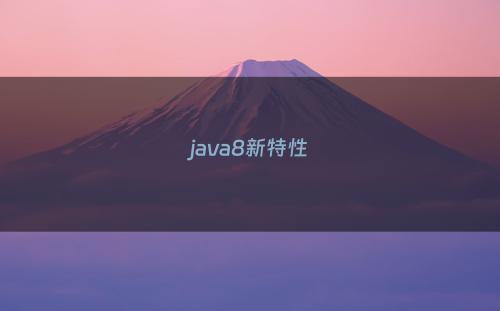1、lambda表达式
public class lamdaTest {
final static String message="1111";
public static void main(String[] args) {
//(parameters) -> expression或(parameters) ->{statements; }
lambda();
}
public static void lambda(){
lamdaTest lamdaTest =new lamdaTest();
//1、构建方法实现
GreetingService greetingService1=message -> System.out.println(message);
GreetingService greetingService2=message -> {
System.out.println(message);
};
//2、方法调用
greetingService1.sayMessage("hello");
greetingService1.sayMessage(message);//只能使用外部被final修饰的变量
//类型声明
MathOperation add=(int a,int b)->a+b;
//不用类型声明
MathOperation sub = (a,b)->a-b;
//大括号内返回结果
MathOperation multip=(a,b)->{return a*b;};
//没有大括号及返回语句
MathOperation division= (int a,int b)->a/b;
//3、将add函数作为参数
System.out.println(lamdaTest.operation(2,4,add));
}
interface MathOperation {
int operation(int a,int b);
}
interface GreetingService{
void sayMessage(String message);
}
//lambda支持将函数作为一个方法的参数 (其实也是将接口对象作为参数)
private int operation(int a,int b,MathOperation mathOperation){
return mathOperation.operation(a,b);
}
}2、方法引用
public class Car {
@FunctionalInterface
public interface Supplier<T> {
T get();
}
//Supplier是jdk1.8的接口,这里和lamda一起使用了
public static Car create( Supplier<Car> supplier) {
return supplier.get();
}
public static void collide( Car car) {
System.out.println("Collided " + car.toString());
}
public void follow( Car another) {
System.out.println("Following the " + another.toString());
}
public void repair() {
System.out.println("Repaired " + this.toString());
}
public static void main(String[] args) {
//构造器引用:它的语法是Class::new,或者更一般的Class< T >::new实例如下:
Car car = Car.create(Car::new);
Car car1 = Car.create(Car::new);
Car car2 = Car.create(Car::new);
Car car3 = new Car();
List<Car> cars = Arrays.asList(car,car1,car2,car3);
System.out.println("===================构造器引用========================");
//静态方法引用:它的语法是Class::static_method,实例如下:
cars.forEach(Car::collide);
System.out.println("===================静态方法引用========================");
//特定类的任意对象的方法引用:它的语法是Class::method实例如下:
cars.forEach(Car::repair);
System.out.println("==============特定类的任意对象的方法引用================");
//特定对象的方法引用:它的语法是instance::method实例如下:
final Car police = Car.create(Car::new);
cars.forEach(police::follow);
System.out.println("===================特定对象的方法引用===================");
}
}3、函数式接口
public class InterfaceTest {
/**
* 函数式编程,在1.8之前,java方法的参数基本还只能是变量,对象,在1.8提出函数式编程后,可以将方法作为参数,大大提高了程序的灵活性。
* @param args
*/
public static void main(String[] args) {
//function【参数,函数定义】
String str = dealString("hello",s->s.toUpperCase());
//supplier
getList(10,()->new Random().nextInt(100));
//consumer
handleConsumer(i-> System.out.println(i),100);
//predicate
List<Integer> list = Arrays.asList(1,2,3,4,5,6,7,8,9);
eval(list,n->n%2==0);
}
public static String dealString(String str, Function<String,String> function){
return function.apply(str);
}
public static List<Integer> getList(int number, Supplier<Integer> supplier){
List<Integer> list = new ArrayList<>();
for(int i=0;i<number;i++){
list.add(supplier.get());
}
return list;
}
public static void handleConsumer(Consumer<Integer> consumer,Integer number){
consumer.accept(number);
}
//推断
public static void eval(List<Integer> list, Predicate<Integer> predicate){
for(Integer n:list){
if(predicate.test(n)){
System.out.println(n+"--");
}
}
}
}4、接口默认方法
默认方法的最典型用法是逐步为接口提供附加功能,而不破坏实现类。
此外,它们还可以用来为现有的抽象方法提供额外的功能。

public interface MyInterface {
// 普通接口方法<br> public void ptMethod();
default void defaultMethod1() {
// 默认方法
}
}
5、stream
public class StreamTest {
static List<Person> personList = new ArrayList<Person>();
static List<Person> personNull = null;
private static void initPerson() {
personList.add(new Person("张三", 8, 3000));
personList.add(new Person("李四", 18, 5000));
personList.add(new Person("王五", 28, 7000));
personList.add(new Person("孙六", 38, 9000));
}
public static void main(String[] args) {
initPerson();
//创建一个比较器
collection();
}
private static void compare() {
Comparator<? super Person> comparator = Comparator.comparingInt(Person::getAge);
Optional<Person> optional =personList.stream().max(comparator);
System.out.println(optional);
}
/**
map: 将参数映射成一个新的元素。【对象-->元素】
flatmap:将参数的每个值映射成一个流,最后合并成一个大流。【每个字符串拆分-->统一合并】
*/
public static void map(){
//map 遍历薪资
List<Integer> persons = personList.stream().map(x->x.getSalary()+500).collect(Collectors.toList());
System.out.println(persons);
//flagmap
String[] arr = {"z, h, a, n, g", "s, a, n"};
List<String> list = Arrays.asList(arr);
list.stream().flatMap(x->{
String[] arrs = x.split(",");
Stream<String> stream = Arrays.stream(arrs);
return stream;
}).collect(Collectors.toList());
System.out.println(list);
}
//归约,也称缩减,顾名思义,"是把一个流缩减成一个值",能实现对集合求和、求乘积和求最值操作。
public static void reduceTest(){
List<Integer> list = Arrays.asList(1,2,3,5);
//求和
int sum = list.stream().reduce((x,y)->x+y).get();
System.out.println("求和:"+sum);
//求积
int ji = list.stream().reduce((x,y)->x*y).get();
System.out.println("求积:"+ji);
//求最值
int max=list.stream().reduce((x,y)->x>y?x:y).get();
System.out.println("最大值:"+max);
}
/**
计数: count
平均值: averagingInt、 averagingLong、 averagingDouble
最值: maxBy、 minBy
求和: summingInt、 summingLong、 summingDouble
统计以上所有: summarizingInt、 summarizingLong、 summarizingDoubl
*/
public static void collection(){
//统计员工人数
Long count = personList.stream().collect(Collectors.counting());
//求平均工资
Double average = personList.stream().collect(Collectors.averagingDouble(Person::getSalary));
//求最高工资
Optional<Integer> max = personList.stream().map(Person::getSalary).collect(Collectors.maxBy(Integer::compare));
//求工资之和
Integer sum = personList.stream().collect(Collectors.summingInt(Person::getSalary));
//一次性统计所有信息
DoubleSummaryStatistics collect = personList.stream().collect(Collectors.summarizingDouble(Person::getSalary));
System.out.println("统计员工人数:"+count);
System.out.println("求平均工资:"+average);
System.out.println("求最高工资:"+max);
System.out.println("求工资之和:"+sum);
System.out.println("一次性统计所有信息:"+collect);
}
}6、Optional
public class OptionalTest {
static List<Person> personList = new ArrayList<Person>();
static List<Person> personNull = null;
private static void initPerson() {
personList.add(new Person("张三", 8, 3000));
personList.add(new Person("李四", 18, 5000));
personList.add(new Person("王五", 28, 7000));
personList.add(new Person("孙六", 38, 9000));
}
public static void main(String[] args) {
initPerson();
//封装Optional对象-->操作Optional对象【非空判断、过滤、映射、规约】-->得到目标结果
Integer totalSalary=
Optional.ofNullable(personNull)
.orElse(personList)
.stream().filter(x -> x.getAge() > 20)
.map(x -> x.getSalary())
.reduce((x,y)->x+y)
.get();
System.out.println("大于20岁人的薪资总和: "+totalSalary);
}
}7、日期
public class DateTest {
/**
LocalTime 时分秒
LocalDate 年月日
LocalDateTime 年月日时分秒
DateTimeFormatter 时间格式
*/
public static void main(String[] args) {
final LocalDate now = LocalDate.now();
System.out.println("今天是 " + now);
System.out.println("1970年到现在一共 " + now.toEpochDay() + " 天");
final int lengthOfYear = now.lengthOfYear();
System.out.println("今年一共 " + lengthOfYear + " 天");
final int lengthOfMonth = now.lengthOfMonth();
System.out.println("本月一共 " + lengthOfMonth + " 天");
final boolean leapYear = now.isLeapYear();
System.out.println("今年是否是闰年:" + leapYear);
final LocalDate firstDayOfMonth = now.with(TemporalAdjusters.firstDayOfMonth());
System.out.println("本月的第一天是 : " + firstDayOfMonth);
//下一个周一
final LocalDate withMONDAY = now.with(TemporalAdjusters.next(DayOfWeek.MONDAY));
System.out.println("下周一日期是 :" + withMONDAY);
System.out.println(" 日期在当前时间之后: " + withMONDAY.isAfter(now));
System.out.println(" 日期在当前时间之前: " + withMONDAY.isBefore(now));
//最后一个周一
final LocalDate lastMONDAY = now.with(TemporalAdjusters.lastInMonth(DayOfWeek.TUESDAY));
System.out.println("本月最后一个周二是 :" + lastMONDAY);
final LocalDate lastDay = now.with(TemporalAdjusters.lastDayOfMonth());
System.out.println("本月最后一天是 : " + lastDay);
// 加一年
final LocalDate plusYears = now.plusYears(1);
System.out.println("当前日期加一年 : " + plusYears);
//两个日期相差天数
System.out.println("两个日期相差天数:" + (plusYears.toEpochDay() - now.toEpochDay()));
final LocalDate plusMonths1 = now.plusMonths(12);
System.out.println("当前日期加12 个月 :" + plusMonths1);
final LocalDate minusDays = now.minusDays(1);
System.out.println("当前日期减 1 天 : " + minusDays);
final LocalDate plusDays = now.plusDays(1);
System.out.println("当前日期加 1 天 : " + plusDays);
final int dayOfMonth = now.getDayOfMonth();
System.out.println("今天是这个月的第 " + dayOfMonth + " 天");
final int monthValue = now.getMonthValue();
System.out.println("本月是今年的第 " + monthValue + "月");
final Month month = now.getMonth();
System.out.println("本月的英文 : " + month);
// 本周的周几
final DayOfWeek dayOfWeek = now.getDayOfWeek();
System.out.println("今天是周几英文: " + dayOfWeek);
System.out.println("今天是本周周几: " + dayOfWeek.getValue());
// string 转 localDate
final LocalDate parse = LocalDate.parse("2021-07-12");
final LocalDate parse1 = LocalDate.parse("2021-07-12", DateTimeFormatter.ofPattern("yyyy-MM-dd"));
System.out.println(parse1);
System.out.println(" 转日期 " + parse);
System.out.println("DateTimeFormatter 转日期 " + parse1);
//获取指定日期
final LocalDate startDate = LocalDate.of(2021, 6, 30);
System.out.println(startDate);
final LocalDateTime nowDateTime = LocalDateTime.now();
System.out.println("当前日期时间:" + nowDateTime);
final LocalTime localTime = LocalTime.now();
System.out.println("当前时间: " + localTime);
final String format = nowDateTime.format(DateTimeFormatter.ofPattern("yyyy-MM-dd HH:mm:ss a"));
System.out.println("当前日期时间 格式化" + format);
}
}